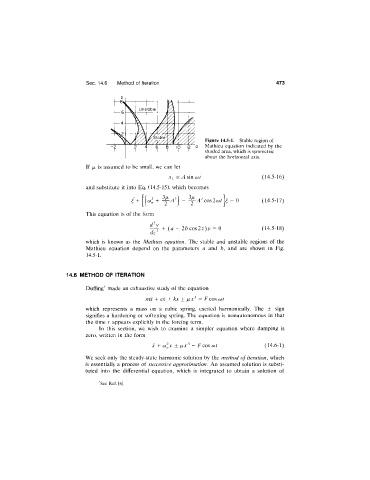Page 486 - Thomson, William Tyrrell-Theory of Vibration with Applications-Taylor _ Francis (2010)
P. 486
Sec. 14.6 Method of Iteration 473
Figure 14.5-1. Stable region of
2 ^ 4^ "" 0 ^ ^ 0 lo" " iV ^ Mathieu equation indicated by the
shaded area, which is symmetric
about the horizontal axis.
If ¡JLis assumed to be small, we can let
jf, = Asin o)t (14.5-16)
and substitute it into Eq. (14.5-15), which becomes
Í + + ^ a A - ^ A ^ coslcot Í - 0 (14.5-17)
This equation is of the form
d^y ^ + {a - 2b cos 2z)y = 0 (14.5-18)
dz
which is known as the Mathieu equation. The stable and unstable regions of the
Mathieu equation depend on the parameters a and b, and are shown in Fig.
14.5-1.
14.6 METHOD OF ITERATION
Duffing^ made an exhaustive study of the equation
mx + ex kx ± ¡ix^ = F cos o)t
which represents a mass on a cubic spring, excited harmonically. The ± sign
signifies a hardening or softening spring. The equation is nonautonomous in that
the time t appears explicitly in the forcing term.
In this section, we wish to examine a simpler equation where damping is
zero, written in the form
X + io^^x ± ¡JLX^ = F cos o)t (14.6-1)
We seek only the steady-state harmonic solution by the method of iteration, which
is essentially a process of successive approximation. An assumed solution is substi
tuted into the differential equation, which is integrated to obtain a solution of
^See Ref. [6].

